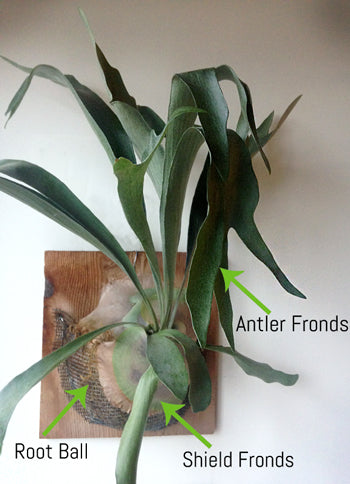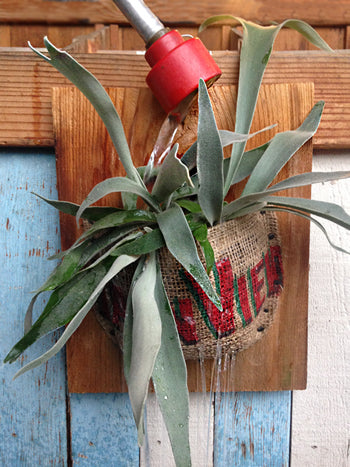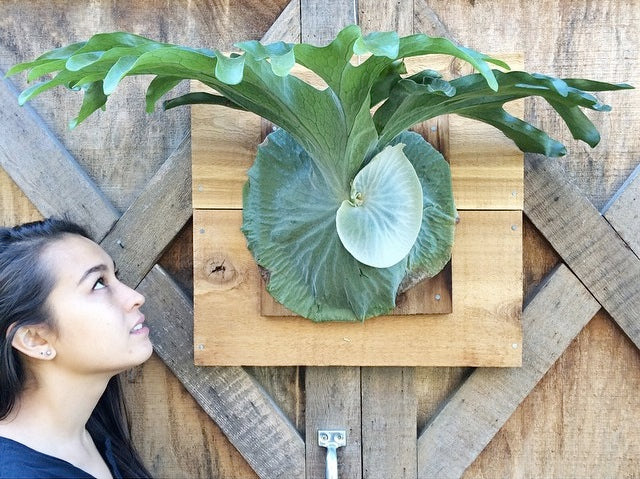Staghorn Fern Care: How To Water, Grow And Care For Mounted Staghorn Ferns
It’s a fact: staghorn ferns are stunning. Mounted on a board, wrapped in vintage burlap, and hung a wall, these plants are truly works of living art.
There are dozens of species of staghorn ferns, and until recently, they were quite rare. Now though–thanks to species native to Australia, Platycerium bifurcatum, that is relatively easy to care for and propagate–they’re increasingly popular house plants.
Staghorn fern care intimidates many people who visit our nursery, and we’ll be the first to admit that these plants can be picky. Before we dive into our best practices for staghorn fern care, it’s essential to know a bit of background information about how these epiphytic beauties grow.
Staghorn Ferns are Epiphytes
Though you can find young staghorn ferns sold in pots, mature plants need to be mounted to a board or hung in a hanging basket. Why? Because, like air plants, staghorn ferns are epiphytic plants, which means that in they grow on other plants or trees in their natural growing environments.
In the tropics (and even warmer parts of the US like Florida), staghorn ferns grow to truly massive proportions, jutting dramatically out of the crooks of trees. Their roots hold them in place, and they absorb water and nutrients through their fronds.
Anatomy of a Staghorn Fern
One of the reasons that staghorn fern care seems daunting is that the plant’s anatomy differs from that of most other common houseplants — even other ferns. There are about 12,000 fern species, and ferns are amongst the most ancient plants. Whereas other plant species reproduce through flowers and seeds, ferns have neither; rather, they release microscopic spores into the air (a bit like mushrooms and mosses), which eventually become new plants.
 Fern leaves are actually called fronds, and staghorn ferns have two types. The first, and most prominent, is the “antler” frond – these are the large, bifurcated leaves that shoot out of the center of the plant, and from which staghorn ferns get their names, since they resemble the antlers of deer or moose. Spores develop on the lower these fronds, and look a bit like brown fuzz — don’t remove the spores! This is a no-no in staghorn fern care.
Fern leaves are actually called fronds, and staghorn ferns have two types. The first, and most prominent, is the “antler” frond – these are the large, bifurcated leaves that shoot out of the center of the plant, and from which staghorn ferns get their names, since they resemble the antlers of deer or moose. Spores develop on the lower these fronds, and look a bit like brown fuzz — don’t remove the spores! This is a no-no in staghorn fern care.
The second type of staghorn fern frond is called the shield frond. These are the round, hard plate-like leaves that surround the base of the plant. Their function is to protect the plant roots, and take up water and nutrients. These fronds start out green, but eventually turn brown and dry up. This is a totally normal part of the staghorn fern life-cycle — in fact, this is one of the most common misconceptions in staghorn fern care. A brown shield frond does not mean your staghorn fern is dying, and dried shield fronds should never be removed!
The final part of the staghorn fern is the root ball. Since stags are epiphytes, their root systems are fairly minimal, and help the plant attach to its home. Because the roots are so minimal, staghorn ferns need extensive drainage and are particularly susceptible to root rot.
Now that we have a bit of background about these mounted beauties, here’s our best practices for staghorn fern care.
Light
How Much Light Does a Staghorn Fern Need?
When you picture a fern, you probably imagine the shady, lush forest floors of the Pacific Northwest. You might then think that your stag will appreciate a dark space, but you would be wrong. Staghorn ferns, on the otherhand, are native to the tropics — the species that we most commonly feature, Platycerium bifurcatum, is native to Australia.
Staghorn ferns need bright, indirect or diffused light to thrive, though they must be protected from the harsh rays of the direct sun. We tell people to put staghorn ferns in the brightest space in their home where, again, the plant will not take direct sun. Rooms with Southern and Eastern exposures tend to be best, though unobstructed North windows will do. Western light is fine, but be careful, as this afternoon exposure tends to be hot and harsh.
Can Staghorn Ferns Survive in Artificial Light?
Unfortunately, the short answer is no. We don’t recommend putting your staghorn in a room without natural sun. Basements tend to be a no-go.
Water
How to Water a Staghorn Fern
 Your watering regimen consists of two processes: misting and soaking.
Your watering regimen consists of two processes: misting and soaking.
Misting your staghorn fern
- Use a spray-bottle that emits a fine, ambient mist, such as a brass mister.
- Mist the entire plant, focusing on the underside of the antler fronds and the shield fronds.
Soaking your staghorn fern
- Dunk your staghorn fern in a sink or basin of water for about a minute, or until the plant’s roots are fully saturated
- Alternately, place the plaque in a sink or bathtub tap, and allow room-temperature water to run through the root ball until it is saturated.
- Allow your plant to drip dry before re-hanging.
How Often to Water a Staghorn Fern
Under and over-watering are the most common causes of staghorn fern failure. There is no hard and fast rule as to how often a staghorn fern will need watering – the amount of light, humidity and heat they receive in your home will dictate your watering schedule. However, here are a few rules that tend to work well for us:
- A good rule of thumb is to water once per week in dry, hot times of year, and once every two to three weeks during cooler months. Start with this schedule, and adjust as necessary depending on your space.
- Staghorn ferns absorb water through their fronds, as well as their roots. This means that they respond well to misting and appreciate humid spaces.
- More humidity = less watering. If your staghorn fern is in a space where it receives lots of ambient humidity, like a bathroom, you’ll probably be able to reduce your misting and watering.
- More light or heat = more watering. During the summer, be especially attentive to your stag. Most species can handle a bit of drought, even to the point of wilting, but not much more. Through summer and fall, mist your plant regularly, and check the moss at the base of the plant regularly for dryness.
- Less light or heat = less watering. Remember – these plants don’t tolerate over-watering. During the winter, you’ll likely need to cut back on watering. Keep in mind, though, that if your plant is directly over a heating duct or near a fireplace, that will dry your plant more quickly.
- If the antler fronds begin to brown or blacken at the base, this is a sign of over-watering. Reduce watering to once monthly until plant shows sign of recovery
- If the antler fronds begin to brown at the tips or wilt, this is a sign of under-watering. Increase watering as needed.
A Note on Moosehorn Ferns
Moosehorn ferns — Plateceryium grande — are more drought tolerant and slightly more susceptible to root-rot than other staghorn fern species.
To water these plants, we recommend that when the soil/moss at the base of the plant feels dry (if no moss is exposed, gauge by weight of mount), place plant under faucet and run the tap so water flows on the board, behind the plant, for about 3-5 minutes.
Try to avoid wetting the foliage. If a black spot appears on the flat shield frond, that is an indication of over-watering. Try decreasing watering and improving air circulation to make sure the plant is able to adequately dry out after watering. This is especially important during winter.
Temperature
Staghorn ferns are surprisingly cold-hardy, but for optimal growth, the temperature should not be allowed to drop below 50 degrees or above 100 degrees.
Staghorn ferns can be placed outdoors when temperatures stay within this range. Be extra careful to keep staghorns out of direct sun and well-watered when hung outdoors. Bring your staghorn fern back inside when temperatures get chilly at night.
Fertilizer
Fertilizing your staghorn fern will promote vigorous growth, especailly in younger plants
Feed your staghorn fern monthly during periods of active grown (spring and summer). Use a balanced, water-soluble fertilizer (ratio of 1:1:1). During periods of dormancy (fall and winter), reduce fertilizing to every other month.
Some people suggest feeding your staghorn fern by slipping a piece of banana peel under the shield frond. We’ve never tried this method, but would love to hear from you if you’ve had success!
Mature staghorn ferns can survive with a twice-yearly feeding.
Remounting Your Staghorn Fern
Our mounted staghorn ferns are intended as permanent installations, and we don’t recommend re-mounting your staghorn fern. Since the plant is epiphytic, the root space on the original board will be sufficient.

However, when the shield fronds begin to creep to the edges of the plaque, standard practice is to attach your board to a larger piece of wood with a few nails (see image). Be careful not to nail through the shield frond or root ball when remounting!

